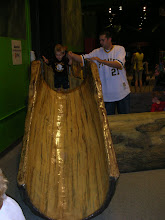For this blog I will discuss Second Life, an online virtual world for networking and educational purposes. I personal have used Second Life as a source of information. Although, there are many sites that are inappropriate for students and classroom settings. Teachers need to be aware of this, and surf the world to ensure their students will not be going on to sites such as these. On the other hand it can be an unbelievable tool for learning.
Sharnell Jackson, the chief eLearning officer for Chicago Public Schools stated that gaming and simulations are highly interactive, allow for instant feedback, immerse students in collaborative environments, and allow for rapid decision-making. Studies of the brain have pointed to data suggesting that repeated exposure to video games reinforces the ability to create mental maps, inductive discovery such as formulating hypotheses, and the ability to focus on several things at once and respond faster to unexpected stimuli (Devaney 2009).
Many education groups, such as ISTE and the Discovery Educator Network (DEN) have active communities in Second Life, a program that immerses users into a virtual world, said Claudia L'Amoreaux, a community developer and educator for Linden Lab, the company behind Second Life. "I call Second Life an engine for creativity," she said. "Today's teens are creating their own content, uploading photos to Flickr and videos to YouTube, and in Second Life they're making their own games and stepping into them--you could call Second Life a participatory game platform (Devaney 2009)." This virtual world allows users to create their own virtual avatars, thus defining their own characters, she added.
Also, An online virtual world that has become one of the web's most popular activities is also becoming an increasingly popular venue for teaching and socialization among educators and youth organizations. The program, called Second Life, which first opened to the public in 2003, immerses participants in a virtual world of their own making. By setting up an account (either paid or free), users are able to create a virtual persona known as an avatar, which they can personalize to look however they want. The program, from San Francisco-based company Linden Lab, allows users to create everything within their virtual world. Users are able to buy and sell plots of land, objects they have created themselves, and so on. The world itself and its economy closely resemble that of the "first life," as some in the virtual community call everyday society (Appel 2009).
Hundreds of thousands of real dollars change hands in Second Life daily, and it would have an annual gross domestic product of around $150 million if it were to stop growing today. Whatever Second Life is, it's clear that it belongs in a different class than the virtual realities of film and fiction that have gone before it. The closest comparison would be to online video games such as "World of Warcraft" or "The Sims Online." Users download free software that opens a portal to Second Life, and Linden Lab's servers draft models of the ever-changing world and send it back to users as a real-time video. The difference is, Second Life is not a game. It doesn't have a goal, and most resources aren't restricted. Characters can fly or breathe water, and they never age or die. With the popularity of Second Life soaring (more than 1.2 million people have joined throughout the world), it was only natural that educators would take notice of the phenomenon and begin exploring the possibilities of turning it into an educational tool (Appel 2009).
Linden Lab has been encouraging educators to take advantage of the multimedia and social-networking possibilities within its program. A year ago, an eMail list was started for educators interested in using Second Life. Within the year, the list has grown to more than 700 educators around the world. In addition, Linden Lab offers the purchase of private islands at discounted rates to educators and nonprofit organizations. If educators want to test out Second Life for a class, Linden Lab will even offer them a free piece of land for the duration of the class. Small private islands are sold for $980, as well as a monthly land fee of $150. A main draw, according to Appel (2009), for educators in using Second Life is the improvement in interaction and expression when compared with programs such as distance-education courses. "I think that is one of the things that's so attractive to educators using Second Life," says Linden Lab community developer Claudia L'Amoreaux, or Claudia Linden as she is known within Second Life (Appel 2009). "The quality of interaction is hard to even describe. It doesn't replace face to face, but it does enable working with people all over the world (Appel 2009)."
References:
Appel, Justin (2009). ‘Second Life’ Develops Education Following. Found September 22, 2009 at www.eschoolnews.com
Devaney, Laura (2009). Gaming Helps Students Hone 21st-Century Skills. Found September 21, 2009 at www.eschoolnews.com

No comments:
Post a Comment